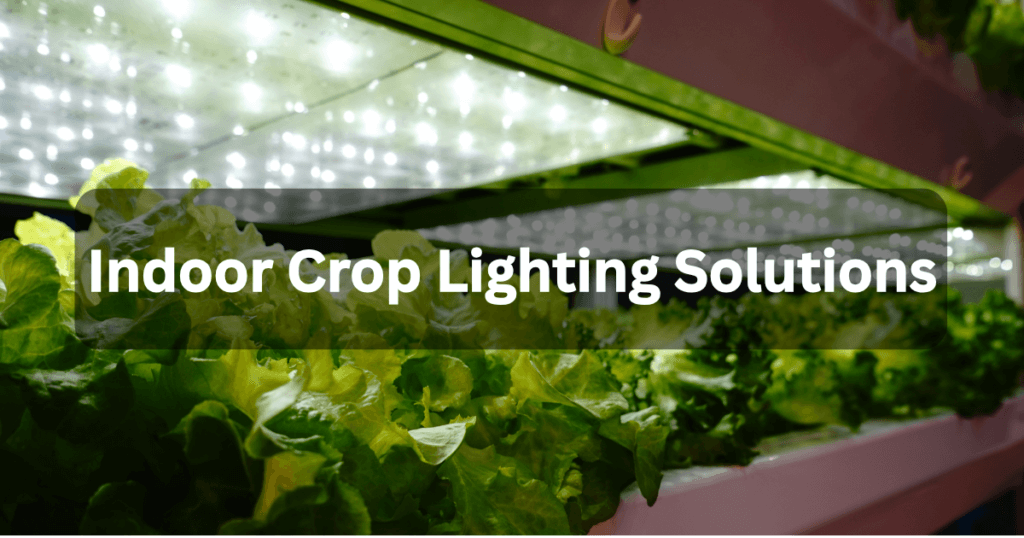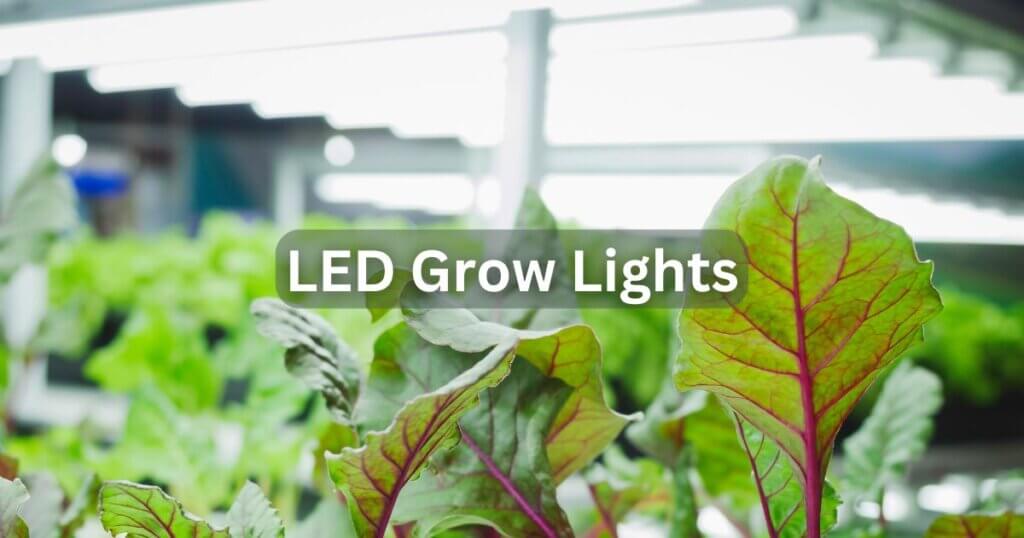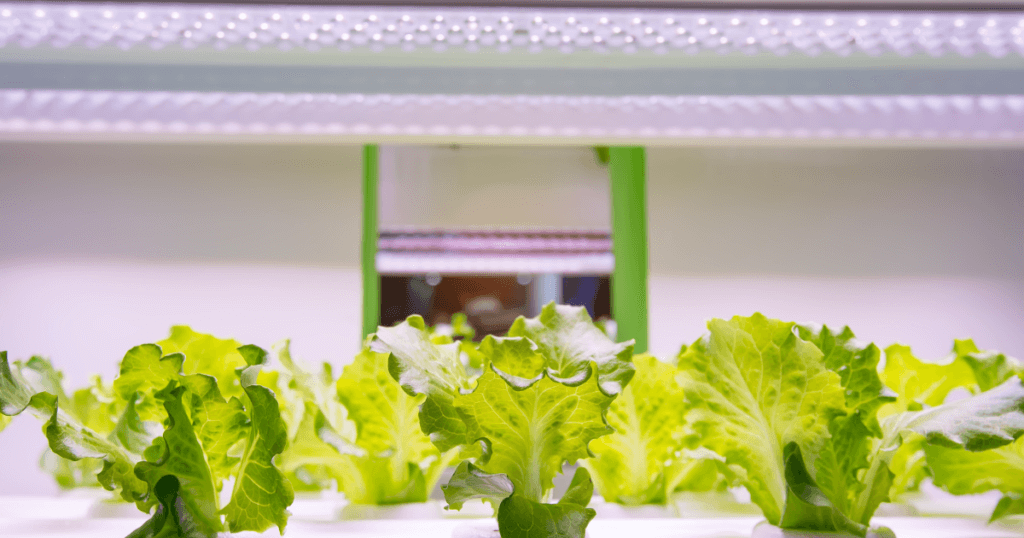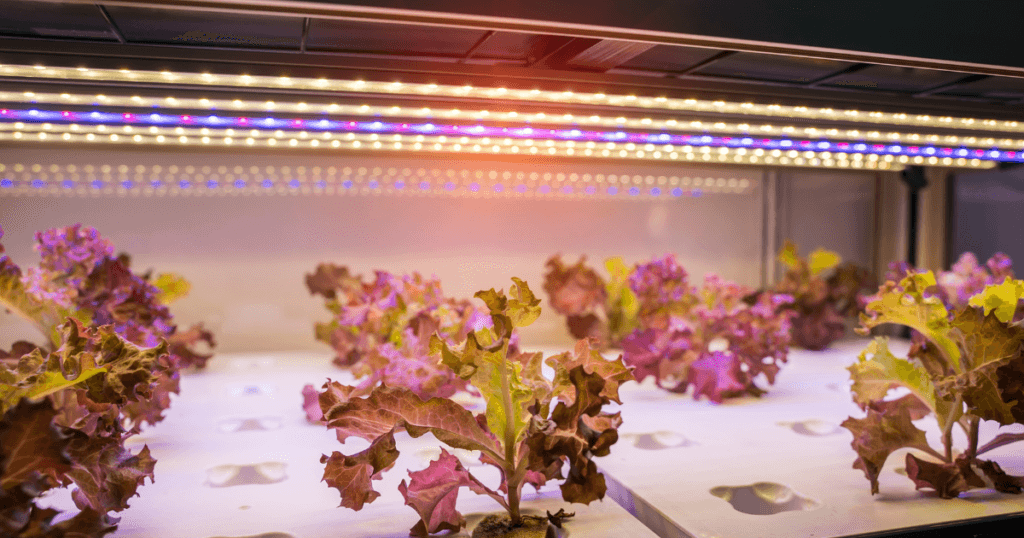Brilliant Indoor Crop Lighting Solutions That Will Supercharge Your Harvests in 2025

Some of the links in this post are affiliate links. As an Amazon Associate, we earn a referral fee from qualifying purchases—at no extra cost to you.
Table of Contents
Why Indoor Crop Lighting Solutions Matter More Than Ever
Indoor crop lighting is transforming how we grow food indoors by providing the essential light plants need for photosynthesis. Natural sunlight is often too weak or inconsistent inside, so artificial lighting mimics the sun’s red and blue wavelengths to support healthy growth. Urban farmers rely on these lighting solutions to achieve consistent, high-quality yields in spaces without adequate natural light. With controlled timing and optimized spectrums, indoor lighting ensures plants thrive at every stage.
Understanding the Science Behind Crop Lighting
Let’s dive into what really matters when choosing indoor crop lighting solutions: the science.
How Plants Use Different Light Spectrums
Blue light boosts leafy growth. Red light triggers flowering and fruiting. Green light? Most of it bounces off, which is why plants look green. Your lighting setup should deliver the right spectrum at the right time. Too much red too early, and your lettuce might bolt. Too little blue, and your kale becomes leggy.
What PAR (Photosynthetically Active Radiation) Really Means
PAR is the part of the light spectrum that plants use for photosynthesis—roughly 400–700 nanometers. Good grow lights list their PAR output in micromoles per square meter per second (µmol/m²/s). High PAR values mean your plants are getting more “edible” light. Think of it as a calorie count for your crops.
The Role of Intensity, Duration, and Light Positioning
Light intensity affects how fast your plants grow. Too weak, and they stall. Too strong, and they burn. Duration matters too—plants need a night cycle to rest. Positioning also makes or breaks results. Lights too far, and you lose intensity. Too close, and you cook your crop.
Types of Indoor Crop Lighting Solutions Available Today
Not all lights are created equal. Here’s what’s out there for indoor growers.
LED Grow Lights: Efficient and Customizable
LEDs are the top pick for most growers. They’re energy-efficient, long-lasting, and customizable. Some models let you fine-tune the light spectrum with a remote or app. Whether you’re growing microgreens or strawberries, there’s an LED setup that fits.
For an energy-efficient, full-spectrum solution, the Spider Farmer SF-2000 LED Grow Light delivers excellent PAR output with minimal heat, making it a favorite for indoor growers.
Fluorescent Lights: Budget-Friendly but Limited
T5 fluorescent lights are popular for seedlings and leafy greens. They’re affordable and easy to install, but they lack power for flowering crops. Still, for small-scale or hobby growers, they’re a solid start.
If you’re just starting out or growing greens and herbs, the Hydrofarm Agrobrite T5 Grow Light offers a budget-friendly way to provide adequate light during early growth stages.
HID Lighting: Powerful but Hot
High-Intensity Discharge (HID) lights like HPS and MH bulbs deliver intense light. They’re great for commercial growers but run hot and use a lot of electricity. You’ll need fans or AC to manage the heat.
New Innovations: Quantum Boards, COBs, and Smart Lighting Systems
Quantum boards and COBs (chip-on-board LEDs) offer powerful, uniform lighting with better efficiency. Paired with smart controls, they allow growers to automate schedules and adjust spectrum settings on the fly.
Choosing the Right Indoor Crop Lighting for Your Needs
There’s no one-size-fits-all solution. You’ve got to match the light to your setup.
Key Factors to Consider (Crop Type, Grow Area, Budget)
Start with the crops you want to grow, since different plants have unique lighting needs. Leafy greens require less intense light than fruiting plants like tomatoes or cannabis. Measure your grow area carefully to ensure complete light coverage. A slightly higher upfront investment in efficient lighting can save you money over time through lower energy costs and better yields.
Comparing Lighting Types for Different Growth Stages
Seedlings need cool, blue light for strong roots and compact growth. Vegging plants prefer a balanced light spectrum to support leaf development. Fruiting and flowering crops thrive under red-spectrum light that boosts production. Some lights are full-spectrum, while others let you switch between stages for maximum efficiency.
Energy Consumption and Heat Output Trade-Offs
HID lights use more power and produce significant heat, often requiring extra cooling. LEDs consume less energy, stay cooler, and reduce the need for ventilation. The upfront cost of LEDs may be higher, but they offer greater efficiency and longer lifespan. Over time, LEDs can save hundreds in energy and maintenance compared to cheaper HID options.
Spectrums That Supercharge Plant Growth
Spectrums aren’t just about color—they’re about results.
Blue Light vs. Red Light: What’s the Difference?
Blue light promotes compact growth, strong stems, and vibrant foliage, making it essential during the seedling and vegetative stages. Red light, on the other hand, stimulates flowering and fruit production, playing a key role in the later growth phases. A balanced combination of both ensures optimal development throughout the entire plant lifecycle. For leafy crops like lettuce, prioritize blue light, while fruiting plants like strawberries benefit from increased red light during their flowering stage.
Full-Spectrum Lighting: A Complete Solution?
Full-spectrum grow lights provide a broad range of wavelengths, from ultraviolet (UV) to infrared (IR), closely mimicking natural sunlight. This makes them ideal for supporting plant health and development across all growth stages. Many indoor growers prefer full-spectrum lights because they reduce the need to switch lighting systems as plants mature. They are known to deliver consistent yields and robust growth, making them a practical all-in-one solution for most crops.
UV and IR: Are They Worth It for Indoor Crops?
Ultraviolet (UV) light can enhance certain plant characteristics, such as flavor, aroma, and pigmentation in herbs and flowers. Infrared (IR) light helps drive flowering and can slightly increase plant size by promoting cell elongation. However, both UV and IR should be used cautiously, as excessive exposure can stress or damage plants. Consider grow lights that include small, adjustable doses of UV and IR for a safe and beneficial spectrum enhancement.
Indoor Crop Lighting Setup Tips for Maximum Results
Even the best lights fail without proper setup.
Ideal Hanging Distances for Common Grow Lights
Placing grow lights too close to your plants can cause leaf burn or stunted growth due to excessive heat and intensity. On the other hand, positioning them too far away may lead to leggy, weak plants that stretch toward the light. Most LED grow lights perform best when hung 12 to 24 inches above the canopy, but this can vary by model and wattage. Always consult the manufacturer’s guidelines and adjust based on how your plants respond, watching for signs of light stress or deficiency.
Light Scheduling: Simulating Day and Night
Just like humans, plants need periods of rest to carry out essential biological processes. During the vegetative stage, a schedule of 16 hours of light and 8 hours of darkness works well to promote healthy growth. When it’s time to flower, switch to a 12 hours on, 12 hours off cycle to simulate shorter days. Using programmable timers ensures consistency and makes light management much easier and more efficient.
Keep your grow lights on a perfect schedule using the BN-LINK WiFi Smart Plug Timer, which lets you control your setup remotely via app or voice.
Measuring Light Levels with PAR Meters
A PAR (Photosynthetically Active Radiation) meter measures the amount of usable light available to your plants, specifically in the 400–700nm range. Think of it as a thermometer for light, giving you precise readings to avoid under- or over-lighting. This tool helps you fine-tune your lighting setup to match plant needs and optimize photosynthesis. While it’s a small investment, it can make a big difference in yield and plant health by ensuring your lights are truly effective.
To get the most out of your lighting, the Apogee MQ-510 PAR Meter helps measure light intensity precisely, ensuring optimal plant growth conditions.
Common Mistakes to Avoid in Indoor Lighting
Lighting is one of the most critical elements in indoor gardening, and getting it wrong can seriously impact plant health and yield. Many growers fall into avoidable traps that hinder growth and waste energy. Understanding common mistakes helps you fine-tune your setup for better results. Let’s look at a few key areas where lighting missteps often occur.
Overexposure and Plant Stress
Providing too much light can stress your plants, leading to burnt leaf tips, discoloration, and overall stunted growth. You might also notice leaves curling upward or fading in color, which are signs of light burn. To fix this, reduce the intensity or increase the hanging distance of your lights. Always observe your plants closely and adjust based on their feedback.
Under-Lighting Your Plants
Insufficient light slows down photosynthesis, resulting in weak, leggy stems and poor overall development. If your plants appear to stretch or lean excessively toward the light source, they’re likely not getting enough intensity. This can lead to reduced yields and longer grow cycles. Make sure your lighting setup delivers adequate coverage and intensity for your specific crop and stage.
Ignoring Ventilation and Heat Management
Even energy-efficient lights like LEDs produce some heat that can build up without proper airflow. Poor ventilation raises temperatures, reduces humidity control, and creates ideal con
Pair your lighting setup with smart airflow using the AC Infinity CLOUDLINE T6 Ventilation Fan to manage heat and humidity effortlessly.
Best Indoor Crop Lighting Solutions for Different Growers
There’s a solution for everyone—from newbies to pros.
Solutions for Beginners and Hobbyists
Start with LED panels or T5s. They’re plug-and-play, safe, and affordable. Perfect for herbs, greens, and small-scale setups.
Lighting Setups for Intermediate Indoor Growers
Upgrade to full-spectrum LEDs or quantum boards. More power, better results, and options to expand as your skills grow.
Advanced Lighting for Commercial-Scale Vertical Farms
Multi-tier LED arrays, climate controls, and smart lighting systems. Precision, efficiency, and automation are the name of the game.
Smart Indoor Lighting Systems: The Future is Here
Technology is redefining how we grow indoors.
Automated Light Controllers and Sensors
Smart systems adjust light based on plant needs. No more guessing. Your crops tell the lights what they need.
App-Based Scheduling and Remote Control
Control your grow lights from your phone. Set schedules, adjust brightness, and monitor stats from anywhere.
AI-Driven Adaptive Lighting Technologies
AI systems learn your crop cycle and adjust lighting automatically. That’s next-level growing—hands-off and high-tech.
Budgeting for Indoor Crop Lighting Systems
You don’t need to break the bank—but you do need to plan.
LED grow lights have a higher upfront cost than traditional lighting but use less energy and last much longer, making them more economical over time. While LEDs typically cost between $200 and $500 per unit and last over five years, HID systems are cheaper initially but require frequent bulb replacements and produce more heat. Considering energy consumption, cooling, and maintenance, HID setups often end up costing more in the long run. Additionally, many regions offer grants and rebates to help offset the cost of energy-efficient lighting, so checking local programs can make upgrading to LEDs even more affordable.
Maintenance and Longevity of Lighting Solutions
Even great lights need care.
Dust buildup on grow lights reduces their efficiency and increases heat, so it’s important to clean them monthly with a soft microfiber cloth. Avoid harsh chemicals and always ensure lights are off and cool before cleaning to prevent damage or injury. Although LEDs last a long time, their light output diminishes over 4 to 5 years, sometimes losing up to 30% of their intensity, which can affect plant health. Using a PAR meter or observing plant growth signs like slow development or stretching can help you know when it’s time to replace or adjust your lighting setup.
DIY Indoor Crop Lighting: Is It Worth It?
If you’re handy, this might be for you.
Building your own LED grow light system can save money and be rewarding if you have basic electronics skills, but it requires purchasing parts like LED chips, heat sinks, and power drivers and following safety guidelines closely. Repurposing old T5 or fluorescent shop lights offers a low-cost alternative for seedlings and leafy greens, though they aren’t suitable for flowering or fruiting crops. While DIY lighting setups can reduce expenses, they carry risks such as electrical hazards, uneven light spectrums, and heat issues that can harm plants. Careful research, thorough testing, and prioritizing safety are essential to avoid poor growth and wasted effort.
For growers interested in building their own lights, the VIVOSUN DIY LED Grow Light Kit provides the core components needed to create a custom solution.
Final Thoughts: Harvest More with the Right Light
Indoor crop lighting solutions are the heart of any successful indoor grow. From choosing the right spectrum to setting timers and measuring output, lighting affects every inch of your plant’s journey. Whether you’re growing basil on your windowsill or running a vertical farm empire, lighting is your silent partner in growth. Invest wisely, and your plants will thank you—with lush leaves, juicy fruits, and non-stop harvests.
FAQs – Indoor Crop Lighting Solutions
1. Can I use regular household LED lights for growing indoor crops?
Household LEDs are not optimized for plant growth. They lack the correct spectrum and intensity (particularly red and blue wavelengths) needed for photosynthesis. While you might see some growth, yields and plant health will be poor compared to dedicated grow lights.
2. How can I tell if my plants are getting too much or too little light?
Too much light causes leaf burn, curling, or bleaching, while too little leads to tall, leggy plants with pale or yellowing leaves. Watching plant behavior and using a PAR meter can help you strike the right balance.
3. Are grow lights safe to leave on for long periods?
Yes—if they’re designed for plant cultivation. Quality LED grow lights are built for continuous use and include safety features. Still, always follow the manufacturer’s recommendations, and never exceed the suggested light cycle for your plants.
4. Should I adjust light settings based on the season or plant growth stage?
Absolutely. Adjust the light spectrum and duration to mimic seasonal changes or specific crop needs. Use more blue light in the vegetative stage and switch to more red light during flowering. Some smart systems can automate this process.
5. How long should I run my grow lights each day for different crops?
Leafy greens typically need 12–16 hours of light daily, while fruiting crops like tomatoes benefit from 14–18 hours. Always include a dark period of at least 6–8 hours to allow plants to rest and complete metabolic processes.
Other Useful Resources Related To Indoor Crop Lighting Solutions
- Aelius LED – Expert-Backed LED Lighting Strategies for 2025
This article delves into advanced LED lighting strategies for modern growers, emphasizing the importance of tailored light spectra and tunable lighting systems. It highlights how specific wavelengths can enhance plant growth, flavor, and nutritional value, and discusses the integration of AI and IoT technologies in lighting solutions.
🔗 https://aeliusled.com/expert-backed-led-lighting-strategies-for-2025/ - Verified Market Reports – Top 7 Trends in the LED Grow Lights Market
This report outlines the latest trends in the LED grow lights market, including the rise of full-spectrum lighting, smart LED systems, and the shift towards vertical farming. It provides insights into how these trends are shaping the future of indoor agriculture.
🔗 https://www.verifiedmarketreports.com/blog/top-7-trends-in-the-led-grow-lights-market/ - SpecGrade LED – How LED Grow Lights Are the Future for Indoor Farming
This article discusses the benefits of LED grow lights in indoor farming, focusing on energy efficiency, customizable light spectra, and improved crop yields. It also explores how modern LED technology allows for precise control over plant growth conditions.
🔗 https://www.specgradeled.com/news/how-led-grow-lights-are-the-future-for-indoor-farming/ - MDPI – Technologies Applied to Artificial Lighting in Indoor Agriculture: A Review
This comprehensive review examines various artificial lighting technologies used in indoor agriculture, analyzing their energy demands, environmental impacts, and scalability. It provides a critical assessment of current lighting solutions and their role in sustainable indoor farming.
🔗 https://www.mdpi.com/2071-1050/17/7/3196 - Indoor Ag-Con – Trend Report 2025
This trend report highlights sustainable and eco-friendly practices in indoor agriculture, including the adoption of advanced LED lighting systems. It features insights from industry leaders like Thrive Agritech, focusing on energy-efficient solutions that enhance plant development and reduce operational costs.
🔗 https://indoor.ag/trend-report-2025/









